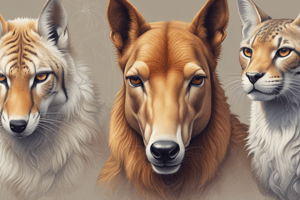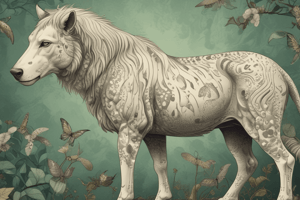Podcast
Questions and Answers
What is the primary goal of selective breeding?
What is the primary goal of selective breeding?
- To study natural selection
- To increase genetic diversity
- To reduce crop yields
- To create organisms with desired characteristics (correct)
Which of the following is an example of natural selection?
Which of the following is an example of natural selection?
- Crops that are resistant to diseases
- Breeding dogs for smaller size
- Survival of organisms with favorable traits in their natural environment (correct)
- Breeding chickens for egg production
What is the first step involved in selective breeding?
What is the first step involved in selective breeding?
- Selection of parents (correct)
- Breeding of offspring
- Mating
- Selection of offspring
What is a limitation of selective breeding?
What is a limitation of selective breeding?
Which of the following is an example of selective breeding in agriculture?
Which of the following is an example of selective breeding in agriculture?
What is the advantage of selective breeding in livestock?
What is the advantage of selective breeding in livestock?
Which of the following is NOT a purpose of selective breeding?
Which of the following is NOT a purpose of selective breeding?
What is the result of breeding organisms with specific traits?
What is the result of breeding organisms with specific traits?
Which of the following is an example of artificial selection?
Which of the following is an example of artificial selection?
What is the desired outcome of selective breeding?
What is the desired outcome of selective breeding?
Flashcards are hidden until you start studying
Study Notes
Selective Breeding
Definition
Selective breeding is the process of intentionally breeding organisms with specific traits or characteristics to produce offspring with those traits.
Purpose
The main purpose of selective breeding is to create organisms with desired characteristics, such as:
- Increased crop yields
- Improved disease resistance
- Enhanced nutritional content
- Desired physical characteristics (e.g. size, color, shape)
Types of Selective Breeding
- Artificial selection: Humans selectively breed organisms to produce desired traits.
- Natural selection: Organisms with favorable traits are more likely to survive and reproduce in their natural environment.
Steps Involved in Selective Breeding
- Selection of parents: Choosing organisms with the desired traits to breed.
- Mating: Breeding the selected parents to produce offspring.
- Selection of offspring: Identifying offspring with the desired traits.
- Breeding of offspring: Breeding the selected offspring to produce more offspring with the desired traits.
Examples of Selective Breeding
- Agriculture: Breeding crops for increased yields, disease resistance, and improved nutritional content (e.g. corn, wheat, rice).
- Livestock: Breeding animals for desired characteristics (e.g. cows for milk production, chickens for egg production).
- Pets: Breeding dogs, cats, and other animals for specific characteristics (e.g. size, coat color, behavior).
Advantages of Selective Breeding
- Improved crop yields: Increased food production to meet growing population demands.
- Disease resistance: Reduced crop loss and improved animal health.
- Improved nutrition: Enhanced nutritional content of crops and livestock.
Limitations of Selective Breeding
- Loss of genetic diversity: Selective breeding can lead to a decrease in genetic variation, making organisms more vulnerable to disease and environmental changes.
- Unintended consequences: Selective breeding can introduce unintended traits or characteristics, which can be detrimental to the organism or ecosystem.
Selective Breeding
Definition
- Selective breeding is the process of intentionally breeding organisms with specific traits or characteristics to produce offspring with those traits.
Purposes and Goals
- To create organisms with desired characteristics.
- Increase crop yields.
- Improve disease resistance.
- Enhance nutritional content.
- Produce desired physical characteristics (e.g. size, color, shape).
Types of Selective Breeding
- Artificial selection: Humans selectively breed organisms to produce desired traits.
- Natural selection: Organisms with favorable traits are more likely to survive and reproduce in their natural environment.
Steps Involved
- Selection of parents: Choosing organisms with the desired traits to breed.
- Mating: Breeding the selected parents to produce offspring.
- Selection of offspring: Identifying offspring with the desired traits.
- Breeding of offspring: Breeding the selected offspring to produce more offspring with the desired traits.
Examples
- Agriculture: Breeding crops for increased yields, disease resistance, and improved nutritional content (e.g. corn, wheat, rice).
- Livestock: Breeding animals for desired characteristics (e.g. cows for milk production, chickens for egg production).
- Pets: Breeding dogs, cats, and other animals for specific characteristics (e.g. size, coat color, behavior).
Advantages
- Improved crop yields: Increased food production to meet growing population demands.
- Disease resistance: Reduced crop loss and improved animal health.
- Improved nutrition: Enhanced nutritional content of crops and livestock.
Limitations
- Loss of genetic diversity: Selective breeding can lead to a decrease in genetic variation, making organisms more vulnerable to disease and environmental changes.
- Unintended consequences: Selective breeding can introduce unintended traits or characteristics, which can be detrimental to the organism or ecosystem.
Studying That Suits You
Use AI to generate personalized quizzes and flashcards to suit your learning preferences.




